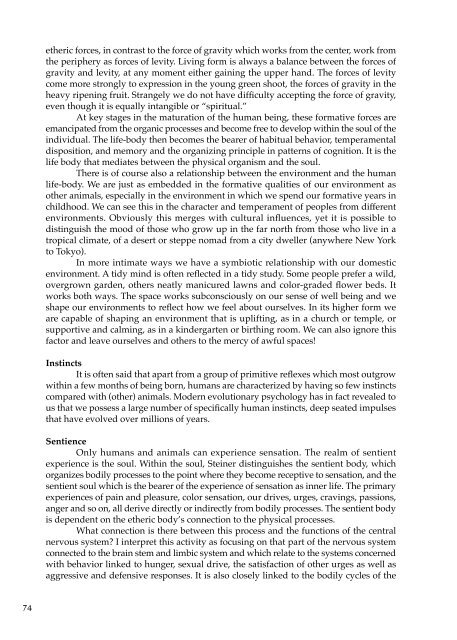The Spirit in Human Evolution - Waldorf Research Institute
The Spirit in Human Evolution - Waldorf Research Institute
The Spirit in Human Evolution - Waldorf Research Institute
Create successful ePaper yourself
Turn your PDF publications into a flip-book with our unique Google optimized e-Paper software.
etheric forces, <strong>in</strong> contrast to the force of gravity which works from the center, work from<br />
the periphery as forces of levity. Liv<strong>in</strong>g form is always a balance between the forces of<br />
gravity and levity, at any moment either ga<strong>in</strong><strong>in</strong>g the upper hand. <strong>The</strong> forces of levity<br />
come more strongly to expression <strong>in</strong> the young green shoot, the forces of gravity <strong>in</strong> the<br />
heavy ripen<strong>in</strong>g fruit. Strangely we do not have difficulty accept<strong>in</strong>g the force of gravity,<br />
even though it is equally <strong>in</strong>tangible or “spiritual.”<br />
At key stages <strong>in</strong> the maturation of the human be<strong>in</strong>g, these formative forces are<br />
emancipated from the organic processes and become free to develop with<strong>in</strong> the soul of the<br />
<strong>in</strong>dividual. <strong>The</strong> life-body then becomes the bearer of habitual behavior, temperamental<br />
disposition, and memory and the organiz<strong>in</strong>g pr<strong>in</strong>ciple <strong>in</strong> patterns of cognition. It is the<br />
life body that mediates between the physical organism and the soul.<br />
<strong>The</strong>re is of course also a relationship between the environment and the human<br />
life-body. We are just as embedded <strong>in</strong> the formative qualities of our environment as<br />
other animals, especially <strong>in</strong> the environment <strong>in</strong> which we spend our formative years <strong>in</strong><br />
childhood. We can see this <strong>in</strong> the character and temperament of peoples from different<br />
environments. Obviously this merges with cultural <strong>in</strong>fluences, yet it is possible to<br />
dist<strong>in</strong>guish the mood of those who grow up <strong>in</strong> the far north from those who live <strong>in</strong> a<br />
tropical climate, of a desert or steppe nomad from a city dweller (anywhere New York<br />
to Tokyo).<br />
In more <strong>in</strong>timate ways we have a symbiotic relationship with our domestic<br />
environment. A tidy m<strong>in</strong>d is often reflected <strong>in</strong> a tidy study. Some people prefer a wild,<br />
overgrown garden, others neatly manicured lawns and color-graded flower beds. It<br />
works both ways. <strong>The</strong> space works subconsciously on our sense of well be<strong>in</strong>g and we<br />
shape our environments to reflect how we feel about ourselves. In its higher form we<br />
are capable of shap<strong>in</strong>g an environment that is uplift<strong>in</strong>g, as <strong>in</strong> a church or temple, or<br />
supportive and calm<strong>in</strong>g, as <strong>in</strong> a k<strong>in</strong>dergarten or birth<strong>in</strong>g room. We can also ignore this<br />
factor and leave ourselves and others to the mercy of awful spaces!<br />
Inst<strong>in</strong>cts<br />
It is often said that apart from a group of primitive reflexes which most outgrow<br />
with<strong>in</strong> a few months of be<strong>in</strong>g born, humans are characterized by hav<strong>in</strong>g so few <strong>in</strong>st<strong>in</strong>cts<br />
compared with (other) animals. Modern evolutionary psychology has <strong>in</strong> fact revealed to<br />
us that we possess a large number of specifically human <strong>in</strong>st<strong>in</strong>cts, deep seated impulses<br />
that have evolved over millions of years.<br />
Sentience<br />
Only humans and animals can experience sensation. <strong>The</strong> realm of sentient<br />
experience is the soul. With<strong>in</strong> the soul, Ste<strong>in</strong>er dist<strong>in</strong>guishes the sentient body, which<br />
organizes bodily processes to the po<strong>in</strong>t where they become receptive to sensation, and the<br />
sentient soul which is the bearer of the experience of sensation as <strong>in</strong>ner life. <strong>The</strong> primary<br />
experiences of pa<strong>in</strong> and pleasure, color sensation, our drives, urges, crav<strong>in</strong>gs, passions,<br />
anger and so on, all derive directly or <strong>in</strong>directly from bodily processes. <strong>The</strong> sentient body<br />
is dependent on the etheric body’s connection to the physical processes.<br />
What connection is there between this process and the functions of the central<br />
nervous system? I <strong>in</strong>terpret this activity as focus<strong>in</strong>g on that part of the nervous system<br />
connected to the bra<strong>in</strong> stem and limbic system and which relate to the systems concerned<br />
with behavior l<strong>in</strong>ked to hunger, sexual drive, the satisfaction of other urges as well as<br />
aggressive and defensive responses. It is also closely l<strong>in</strong>ked to the bodily cycles of the<br />
74
















